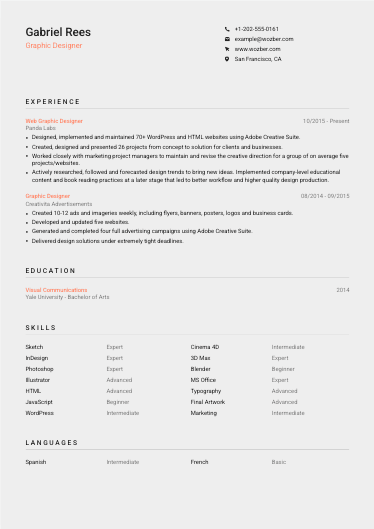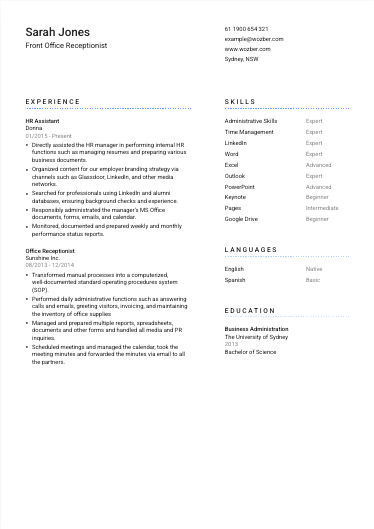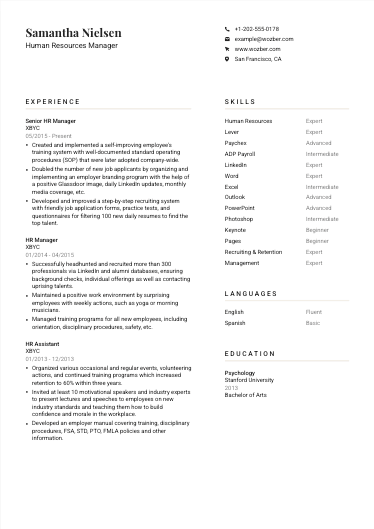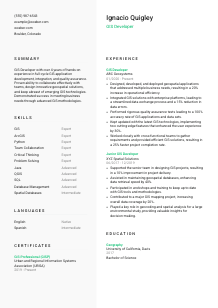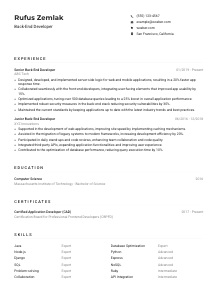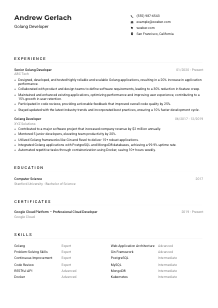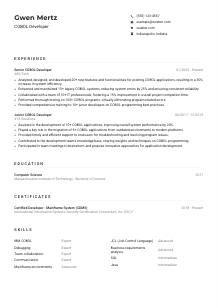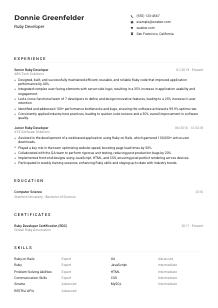GIS Developer CV Example
Plotting points, but your CV doesn't connect? Explore this GIS Developer CV example, mapped out using Wozber free CV builder. Grasp how effortlessly you can blend your spatial wizardry with job specs, paving the way for a career that's always on the right coordinates!

How to write a GIS Developer CV?
Embarking on your journey to land that dream GIS Developer position? Your CV is not just a piece of paper – it's a compass that guides potential employers to see your true worth. Carving out a CV that speaks directly to the job requirements, while ensuring it's friendly to Applicant Tracking Systems (ATS), is a craft in itself.
Fret not, as this guide, powered by Wozber's free CV builder, is your GPS to a CV that makes hiring managers take notice. Let's navigate the terrain of creating a CV that not only checks all the boxes but also showcases your unique strengths and qualifications.
Personal Details
Your personal section is akin to the metadata of a GIS map – providing essential information at a glance. Let's calibrate your CV's personal details to make sure they're pinpoint-accurate and resonate with the specifics of the GIS Developer role. Each detail sets the groundwork for your professional narrative.
1. Mark Your Name Clearly
Think of your name as the title of your personal GIS layer. Ensure it's prominently displayed at the top of your CV with clear, professional typography, setting the stage for what follows.
2. Align Your Title with The Role
Directly below your name, tailor your professional title to mirror the role you're applying for. If the job description reads "GIS Developer," that's the title you want to display. It's a form of ATS optimisation, helping your CV to match the job listing effectively.
3. Craft a Professional Contact
Include your phone number and a professional email address. In the realm of GIS, clarity and precision are paramount, so apply these principles to ensuring your contact details are accurate and easily accessible.
4. Plot Your Location
Since the job description mentions Boulder, Colorado, include your city and state. This is a little like geo-tagging yourself in the right location, reassuring the hiring manager that you're either in the area or willing to relocate.
5. Link to Your Professional Portfolio
GIS Developers often have portfolios or personal websites showcasing their projects. Including a URL to your professional site can serve as a dynamic layer to your CV, providing depth and evidence of your skills.
Takeaway
With precision and a touch of personal brand clarity, your personal details section can make a strong initial impact. Keep it professional, relevant, and tailored to the GIS Developer role. It's the first step in making your CV map-worthy for potential employers.





Experience
The terrain of your professional history can be as varied as a topographic map, but what matters most is highlighting the landmarks that make you the ideal candidate for the GIS Developer role. Follow these steps to ensure your experience section navigates the right points.
- Designed, developed, and deployed geospatial applications that addressed multiple business needs, resulting in a 20% increase in operational efficiency.
- Integrated GIS solutions with enterprise platforms, leading to a streamlined data exchange process and a 15% reduction in data errors.
- Performed rigorous quality assurance tests leading to a 100% accuracy rate of GIS applications and data sets.
- Kept updated with the latest GIS technologies, implementing two cutting‑edge features that enhanced the user experience by 30%.
- Worked closely with cross‑functional teams to gather requirements and provided efficient GIS solutions, resulting in a 25% faster project completion rate.
- Supported the senior team in designing GIS projects, resulting in a 10% improvement in project delivery.
- Assisted in maintaining geospatial databases, enhancing data retrieval speed by 40%.
- Participated in workshops and training to keep up‑to‑date with GIS tools and methodologies.
- Contributed to a major GIS mapping project, increasing overall data coverage by 20%.
- Played a key role in geocoding and spatial analysis for a large environmental study, providing valuable insights for decision‑making.
1. Align with Job Requirements
Start by dissecting the job description and matching your past roles that align with being a GIS Developer. Highlight programming languages used, GIS projects managed, and systems integrated.
2. Structure Your Professional Journey
List your positions in reverse-chronological order, ensuring each entry includes your job title, company name, and dates of employment. This provides a clear, navigable path through your career progression.
3. Highlight Key Achievements
Under each role, focus on specific projects or contributions that align with the responsibilities and requirements outlined in the job description. Phrases like "Designed and deployed geospatial applications..." or "Integrated GIS solutions..." resonate with the role's expectations.
4. Quantify Your Impact
Use data points wherever possible to quantify your achievements. Whether it's increasing operational efficiency by a percentage or reducing data errors, tangible metrics make your accomplishments more concrete.
5. Ensure Relevance
Especially when dealing with GIS, it's easy to get into the weeds with technical details. While detail is good, make sure every point clearly connects to the core responsibilities of a GIS Developer.
Takeaway
Your experience section is the contour lines of your professional map – it provides depth and dimension to your career. By carefully choosing what to highlight, you ensure that you're plotting a journey that leads directly to your next opportunity as a GIS Developer.
Education
In the geography of your CV, the education section marks your academic starting point. Let's input the right coordinates to align your education with the GIS Developer role, reinforcing your candidacy.
1. Identify Key Educational Requirements
The role requires a Bachelor's degree in a relevant field. If your degree aligns with Geography, GIS, Computer Science, or a similar field, ensure it's prominently listed.
2. Structure with Simplicity
Keep the education section straightforward: degree title, field of study, institution name, and graduation date. This clarity helps the reader quickly confirm your academic credentials match the role's needs.
3. Tailor Your Degree Details
If your specific degree directly matches one mentioned in the job requirements, highlight it. For example, "Bachelor of Science in Geography" should be clearly stated to align perfectly with the GIS Developer's role expectations.
4. Mention Relevant Courses or Projects
If recent or particularly relevant, outline key courses or projects that demonstrate your proficiency and interest in GIS development. This can provide more color to your educational background, showing a proactive engagement with your field.
5. Highlight Additional Academic Achievements
Did you graduate with honors, or were you part of a relevant academic organisation? While not as critical for experienced professionals, for those newer to the field, such details can add depth to your qualifications.
Takeaway
Your educational background lays the foundational grid upon which your career is built. Ensuring this section is clearly and accurately presented confirms to hiring managers that you have the academic credentials necessary for a GIS Developer role.
Certificates
In GIS, staying current with certifications can provide a competitive edge, adding layers of specialization and expertise to your CV. Here's how to let your certificates do the talking and prove your ongoing commitment to the field.
1. Identify
First, review the job posting for any explicit certification requirements. While our GIS Developer role doesn't specify any, it's imperative to include certifications that showcase your knowledge and skills in GIS development, like the GISP certification.
2. Choose Wisely
When listing certificates, prioritize those most aligned with the job's demands. It's about quality, not quantity – focusing on a few relevant certifications will make a stronger impact than a lengthy list.
3. Date Transparency
Indicate the acquisition or expiration dates of certifications, especially for ones that are highly relevant in the rapidly evolving GIS field. This shows recruiters your certifications are up to date.
4. Keep Learning
The tech landscape, especially in GIS, is always shifting. Emphasize your commitment to continual learning and staying on the cutting edge of GIS technologies and methodologies.
Takeaway
Your certifications layer additional depth onto your professional profile, highlighting your specialized knowledge and dedication to the GIS field. Ensure this section of your CV is carefully curated to reflect the most relevant and recent achievements.
Skills
Skills in GIS development are your compass points – guiding the direction of your career. Let's plot the most relevant hard and soft skills on your CV, ensuring it's navigated towards the role's requirements.
1. Analyze the Job Listing
Diligently parse through the job description, identifying both the explicitly required and implicitly valuable skills needed for a GIS Developer. Look for keywords like "ArcGIS," "Python," and "database management."
2. Match and List
Prioritize listing skills that directly match those mentioned in the job description. Highlighting expertise in "ArcGIS," "Python programming," and "team collaboration" explicitly ties your capabilities to what the role is looking for.
3. Organize and Prioritize
While you may possess a broad skill set, focus on organizing your skills in a way that showcases the most relevant ones for the GIS Developer role at the top. This aids in ATS optimisation and makes your CV more reader-friendly.
Takeaway
Your skills section is a navigational tool that points hiring managers towards understanding your expertise and fitness for the role. Keep it precise, relevant, and geared towards demonstrating the value you bring as a GIS Developer.
Languages
As GIS maps the world, the ability to communicate across multiple languages can prove invaluable. While the GIS Developer role may prioritize English, showcasing additional language skills can set you apart.
1. Evaluate Requirements
Scan the job description for any language preferences. Our GIS Developer role states English proficiency, so ensure your command of English is clearly marked as "Native" or "Fluent."
2. Place Essential Languages First
List languages in order of relevance to the role, with English at the forefront for this particular GIS Developer position. This immediately checks off a vital requirement for potential employers.
3. Showcase Other Languages
Even if not explicitly required, additional languages can enhance your profile. They demonstrate an ability to work in diverse environments or international projects, a plus in the global reach of GIS.
4. Accurately Reflect Proficiency
Honesty in your language proficiency levels — whether it's "Native," "Fluent," "Intermediate," or "Basic" — offers a truthful picture of your capabilities and avoids potential misunderstandings.
5. Consider the Role's Scope
While English suffices for most GIS Developer roles, being multilingual could be a significant asset, especially for positions with a broader, more global focus. Reflect on how your linguistic skills can further position you as an outstanding candidate.
Takeaway
Your language skills can broaden the scope of your professional opportunities and collaborations in GIS. Highlighting these abilities can subtly enhance your attractiveness as a candidate, providing evidence of your capability to navigate diverse and global teams.
Summary
The summary is your opportunity to encapsulate your GIS Developer identity in a concise and compelling way. This section draws the map that guides the reader through the rest of your CV. Let's plot the points that make your summary a powerful opening statement.
1. Synthesize the Job Essence
Immerse yourself in the job description to grasp the core attributes and skills the role demands. This insight will help you frame a summary that resonates with the very essence of being a GIS Developer.
2. Start with a Strong Introduction
Begin with a clear statement about who you are professionally, referencing your years of experience and areas of specialization. For example, "GIS Developer with over 4 years of hands-on experience..." sets a solid foundation.
3. Highlight Matching Qualifications and Skills
Directly address key requirements from the job listing, weaving in your corresponding skills and achievements. Mentioning proficiency in "ArcGIS" and "Python," along with tangible accomplishments, aligns perfectly with the expectations.
4. Keep It Brief and Impactful
The summary should be succinct, packing a punch in just a few lines. It's like creating a map legend – it doesn't tell the whole story, but it gives essential insights that guide the understanding of the whole.
Takeaway
Your CV summary is the compass rose on your professional map, providing direction and clarity from the outset. A well-crafted summary sets the tone for what follows, positioning you as the GIS Developer candidate who not only meets but exceeds expectations.
Launching Your GIS Developer Journey
As we conclude this guide, you're armed with the tools and strategies to craft a CV that's not just ATS-compliant, but one that vividly showcases your expertise and qualifications as a GIS Developer. Remember, your CV is more than a document; it's a narrative of your professional journey. With Wozber's free CV builder at your service, including ATS-friendly CV templates and an ATS CV scanner, you're well on your way to creating a CV that leads you to the career you've mapped out for yourself.
The world of GIS awaits your expertise. It's time to plot your course and embark on an exciting new professional adventure.

- Bachelor's degree in Geography, GIS, Computer Science, or related field.
- Minimum of 3 years of experience in GIS application development using programming languages such as Python, C++, or Java.
- Proficiency in using GIS software such as ArcGIS, QGIS, or Google Earth Pro.
- Strong database management skills, with experience in SQL and spatial databases.
- Excellent communication skills and the ability to work collaboratively in a team environment.
- English language competency is a must.
- Must be located in or willing to relocate to Boulder, Colorado.
- Design, develop, and implement geospatial solutions and applications to meet specific business needs.
- Integrate GIS with other enterprise systems, platforms, and data sources.
- Perform quality assurance on data and applications to ensure accuracy and efficiency.
- Stay updated on the latest GIS technologies, tools, and industry trends to provide innovative solutions.
- Collaborate with cross-functional teams to understand user requirements, and provide recommendations for GIS solutions.

